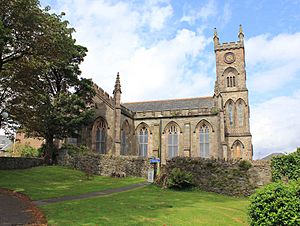High Kirk, Dunoon facts for kids
Quick facts for kids High Kirk |
|
|---|---|
| Old Parish Church | |

High Kirk, 2011
|
|
| 55°56′50″N 4°55′32″W / 55.947188°N 4.925433°W | |
| Location | Dunoon, Argyll and Bute |
| Country | Scotland, United Kingdom |
| Denomination | Church of Scotland |
| Website | Cowal Kirk Website |
| History | |
| Status | Closed |
| Architecture | |
| Functional status | Closed |
| Heritage designation | Category B listed building |
| Designated | 20 July 1971 |
| Architect(s) | James Gillespie Graham |
| Architectural type | Gothic Revival |
| Years built | 1816 |
The High Kirk, also known as the Old Parish Church, is a historic church building in Dunoon, Scotland. It belongs to the Church of Scotland. This beautiful church is found on Kirk Street, just south of the town center. It was built in a style called Gothic Revival. This means it looks like old Gothic churches. The building is so important that it's listed as a Category B historic building. The church held its last service on October 1, 2023, and is now closed.
Contents
History of the High Kirk
Building the Church
The High Kirk was finished in 1816. It was designed by a famous architect named James Gillespie Graham from Edinburgh. The church was built close to where an even older church once stood. That older church was from the 1400s.
Changes Over Time
The church was made bigger in 1834 by David Hamilton from Glasgow. Five years later, the church's tower was made taller by eight feet. This tower has a clock on each of its four sides. These clocks were a gift from William Campbell. In 1909, another architect, Andrew Balfour, made the church longer and wider. The beautiful window in the front part of the church, called the chancel, was made in 1939 by Douglas Hamilton.
The Graveyard
The church has a very old graveyard. Some of the gravestones there are from the 1200s! Important people are buried here. These include bishops like Andrew Boyd, John Cameron (who passed away in 1623), and Hector McLean.
More to Explore
- List of listed buildings in Dunoon

